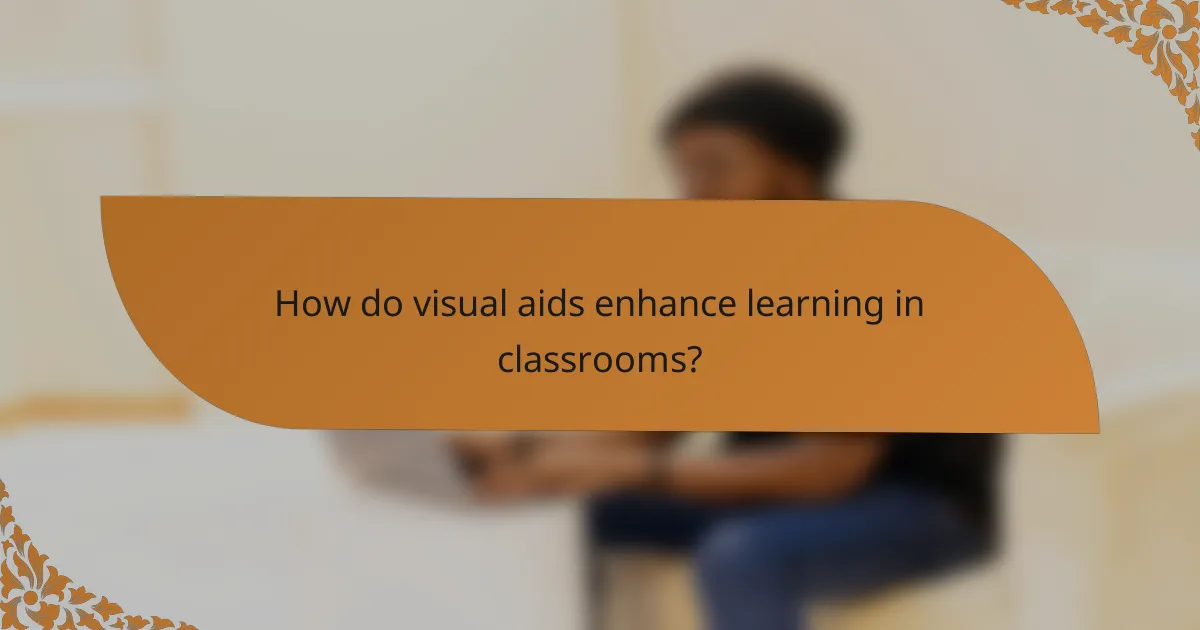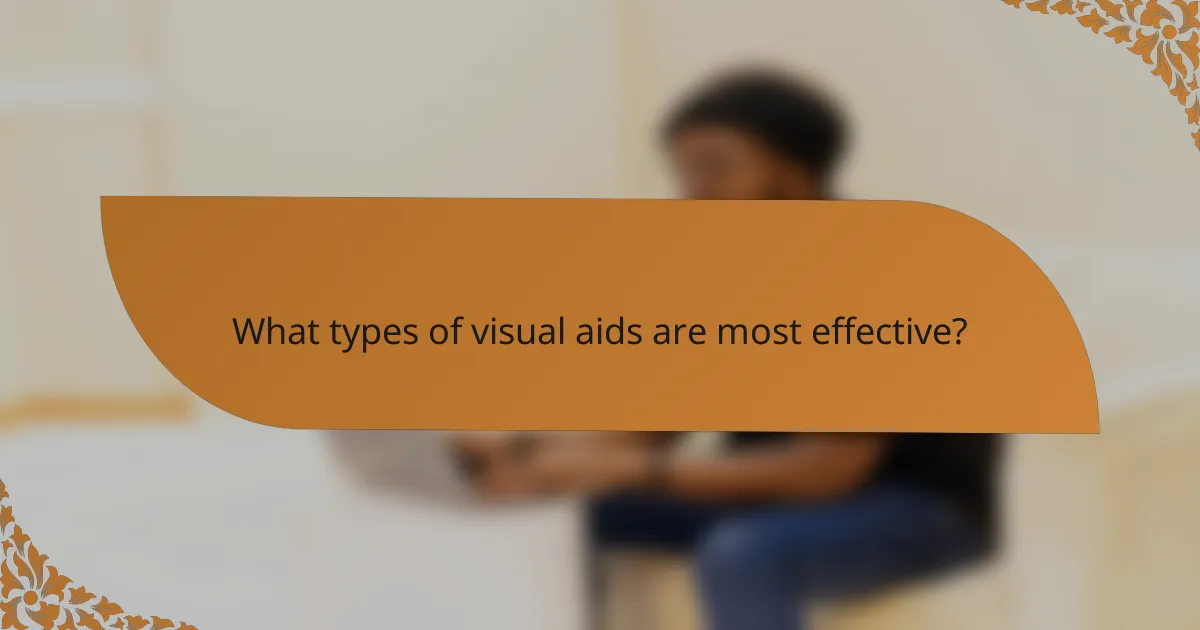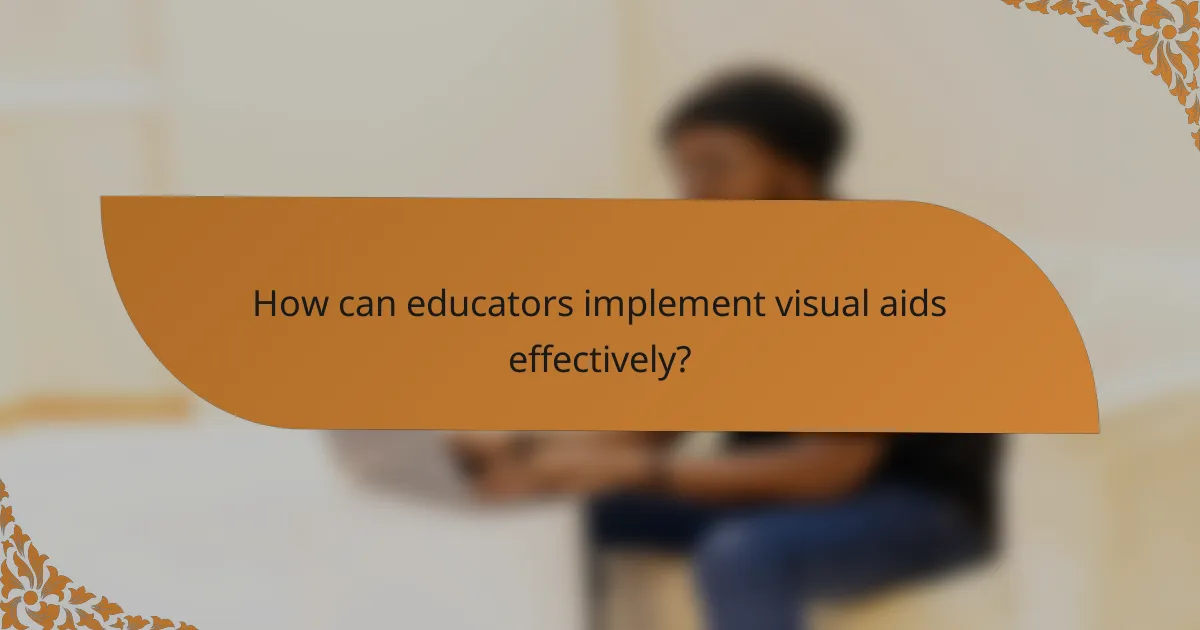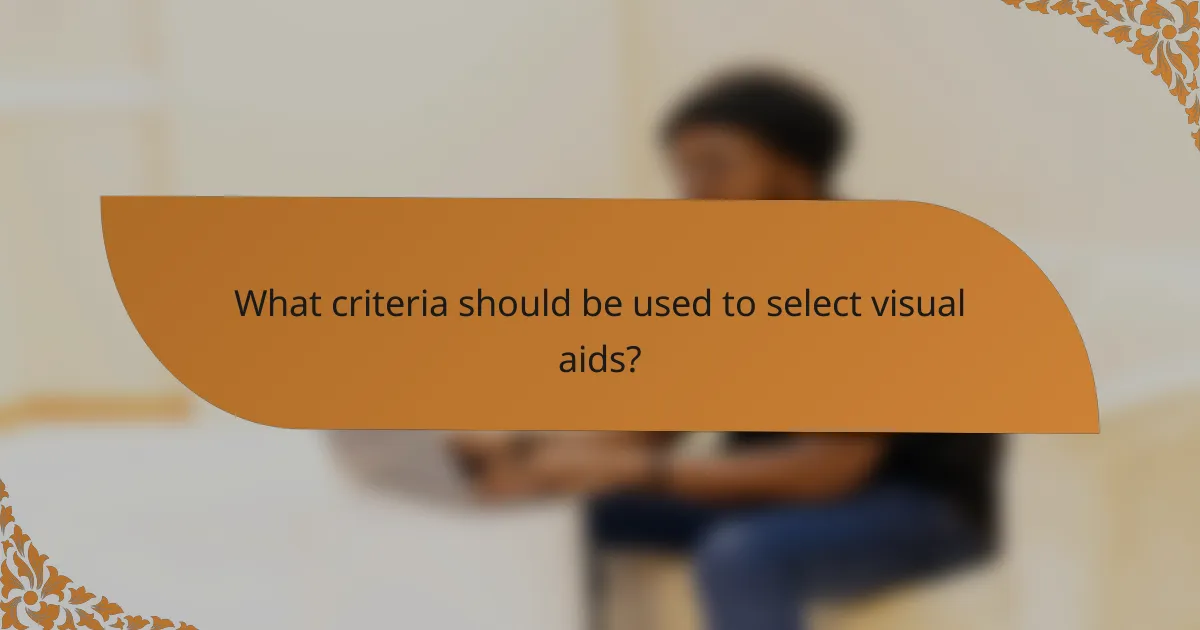Visual aids play a crucial role in enhancing learning by providing clear graphical representations of information, which significantly boost comprehension and retention. By catering to diverse learning styles, these tools help students engage with complex material more effectively. Incorporating various types of visual aids, such as infographics and videos, into educational practices can lead to a more dynamic and impactful learning experience.

How do visual aids enhance learning in classrooms?
Visual aids enhance learning in classrooms by providing students with graphical representations of information, which can significantly improve comprehension and retention. These tools cater to various learning styles, making it easier for students to grasp complex material and stay engaged in the learning process.
Improved retention rates
Visual aids can lead to improved retention rates by allowing students to process information more effectively. Studies suggest that people remember information presented visually better than through text alone, often recalling up to 65% of visual content compared to only 10% of written information after three days.
Using diagrams, charts, and infographics can reinforce key concepts and make them more memorable. For instance, a well-designed infographic summarizing a lesson can serve as a quick reference that students can revisit, enhancing long-term retention.
Increased engagement levels
Incorporating visual aids into lessons can significantly increase student engagement levels. When students interact with visual content, they are more likely to participate actively in discussions and activities. This interaction can lead to a more dynamic classroom environment.
Teachers can use tools like videos, slideshows, and interactive whiteboards to capture students’ attention. For example, a short educational video can break the monotony of traditional lectures and stimulate interest in the subject matter.
Facilitated understanding of complex concepts
Visual aids facilitate the understanding of complex concepts by breaking down information into digestible parts. When abstract ideas are represented visually, students can better grasp relationships and hierarchies within the material.
For instance, using flowcharts to illustrate processes or timelines to depict historical events can clarify intricate subjects. This approach helps students visualize connections and enhances their ability to analyze and synthesize information.

What types of visual aids are most effective?
Effective visual aids enhance learning, comprehension, and retention by presenting information in a clear and engaging manner. The most impactful types include infographics, charts and graphs, and videos and animations, each serving unique purposes in the learning process.
Infographics
Infographics combine text and visuals to convey complex information quickly and clearly. They are particularly effective for summarizing data or illustrating relationships between concepts. A well-designed infographic can enhance understanding by breaking down information into digestible parts.
When creating infographics, focus on clarity and simplicity. Use a limited color palette and clear fonts to avoid overwhelming the viewer. Aim for a balance between visuals and text, ensuring that each element serves a purpose in conveying the message.
Charts and graphs
Charts and graphs are powerful tools for visualizing numerical data and trends. They allow learners to see patterns and comparisons at a glance, making them ideal for presenting statistical information. Common types include bar charts, line graphs, and pie charts, each suited for different kinds of data representation.
To maximize effectiveness, choose the right type of chart for your data. For example, use line graphs for showing trends over time and pie charts for illustrating proportions. Keep labels clear and concise, and avoid cluttering the chart with excessive information.
Videos and animations
Videos and animations engage learners by combining visual and auditory elements, making complex topics more accessible. They can illustrate processes, demonstrate concepts, or provide real-world examples, enhancing comprehension and retention. Short, focused videos are often more effective than longer ones.
When using videos, ensure they are high-quality and relevant to the topic. Consider incorporating subtitles for accessibility and to cater to different learning styles. Keep videos concise, ideally under five minutes, to maintain viewer attention and facilitate better retention of information.

How can educators implement visual aids effectively?
Educators can implement visual aids effectively by integrating them into lesson plans, utilizing technology tools, and training teachers on visual literacy. These strategies enhance student engagement and improve comprehension and retention of information.
Integrating visuals into lesson plans
To integrate visuals into lesson plans, educators should identify key concepts that can be represented graphically. This can include diagrams, charts, and infographics that clarify complex ideas. For instance, using a flowchart to explain a scientific process can help students visualize the steps involved.
Additionally, visuals should be aligned with learning objectives. Teachers can create a checklist to ensure that each visual aid serves a specific purpose in enhancing understanding. Common pitfalls include overloading slides with too much information or using irrelevant images that distract from the lesson.
Using technology tools like Canva
Technology tools such as Canva can simplify the creation of visually appealing educational materials. Educators can use templates to design presentations, posters, and infographics that are tailored to their lesson content. This not only saves time but also enhances the overall aesthetic of the materials.
When using Canva, teachers should focus on clear layouts and cohesive color schemes to maintain student attention. It is beneficial to incorporate interactive elements, such as clickable links or embedded videos, to further engage learners. However, educators should avoid overly complex designs that may confuse students.
Training teachers on visual literacy
Training teachers on visual literacy is crucial for effective implementation of visual aids. Professional development sessions can focus on understanding how to select and create visuals that enhance learning. This training should cover the principles of design, such as contrast, alignment, and hierarchy, which contribute to effective visual communication.
Moreover, educators should be encouraged to share best practices and resources with one another. Establishing a community of practice can help teachers refine their skills and stay updated on new tools and techniques. Regular feedback on visual materials can also foster continuous improvement in their use of visuals in the classroom.

What are the benefits of visual aids for remote learning?
Visual aids significantly enhance remote learning by improving comprehension and retention of information. They help learners grasp complex concepts more easily and maintain engagement during online sessions.
Enhanced clarity in online presentations
Visual aids provide clarity in online presentations by breaking down information into digestible formats. Charts, graphs, and images can illustrate key points, making it easier for learners to understand and remember the material.
For instance, using a flowchart to outline a process can help learners visualize the steps involved, reducing confusion. This clarity is crucial in remote learning environments where direct interaction is limited.
Support for diverse learning styles
Visual aids cater to various learning styles, accommodating visual, auditory, and kinesthetic learners. By incorporating images, videos, and infographics, educators can engage students who may struggle with traditional text-based materials.
For example, a video demonstration can effectively teach a practical skill, while a diagram can help visual learners grasp theoretical concepts. This diversity in presentation helps ensure that all students can access and benefit from the content.
Increased accessibility for learners
Visual aids enhance accessibility for learners by providing alternative ways to engage with content. This is particularly important for students with disabilities, who may find traditional text challenging to navigate.
Using captions in videos, descriptive images, and color-coded materials can make learning more inclusive. Additionally, tools like screen readers can interpret visual aids, ensuring that all students have equal opportunities to learn effectively.

What criteria should be used to select visual aids?
Selecting visual aids requires careful consideration of their relevance to learning objectives, engagement potential, and the quality and clarity of the visuals. These criteria ensure that the aids effectively enhance understanding and retention of the material presented.
Relevance to learning objectives
Visual aids must align closely with the specific learning objectives of the lesson or training session. This means that each visual should directly support the key concepts being taught, helping learners to grasp essential information without distraction.
For example, if the goal is to teach a scientific concept, diagrams or charts illustrating that concept can be particularly effective. Always ask whether the visual aid contributes meaningfully to the learning goals before including it.
Audience engagement potential
The ability of visual aids to engage the audience is crucial for effective learning. A well-chosen visual can capture attention and stimulate interest, making the learning experience more interactive and enjoyable.
Consider the demographics and preferences of your audience when selecting visuals. For instance, younger audiences may respond better to colorful graphics and videos, while professional settings might benefit from infographics or data charts that convey information succinctly.
Quality and clarity of visuals
The quality and clarity of visual aids significantly impact their effectiveness. High-resolution images, clear fonts, and well-structured layouts enhance comprehension and retention, while poorly designed visuals can confuse or mislead learners.
When evaluating visuals, ensure they are not overcrowded with information. A good rule of thumb is to limit text to a few key points and use visuals to complement rather than replace verbal explanations. Aim for a balance that maintains clarity and supports the learning process.

How do visual aids impact student performance?
Visual aids significantly enhance student performance by improving understanding and retention of information. They help learners process complex concepts more easily, leading to better engagement and higher academic achievement.
Higher test scores
Utilizing visual aids can lead to higher test scores among students. Research indicates that students who engage with diagrams, charts, and other visual materials often perform better on assessments compared to those who rely solely on text-based resources.
Visual aids help clarify difficult concepts and provide a reference point for students during study sessions. For instance, a well-structured infographic can summarize key points from a lesson, making it easier for students to recall information during exams.
To maximize the benefits of visual aids, educators should select visuals that directly relate to the material being taught. Simple, clear images or graphs that highlight essential data can be particularly effective. Avoid cluttered visuals that may confuse rather than clarify, as this can detract from the learning experience.
